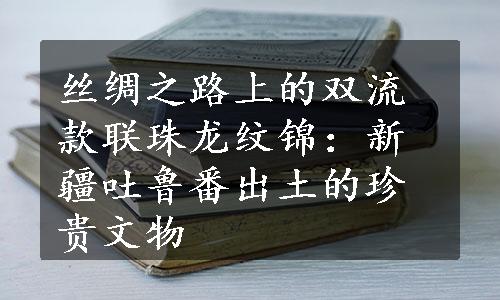
Brocade w ith pearl roundel and dragon design found on silk roads
锦的制作工艺极其复杂,有“寸锦寸金”的说法。成都产蜀锦历史悠久。“蜀” 字最早便是蚕的意思。古蜀王蚕丛建都瞿上,教民养蚕织布,可以看作是蜀锦的开端。汉代成都专设了锦官对蜀锦生产进行管理,锦官城由此而来。“圜阓之里,伎巧之家;百室离房,机杼相和;贝锦斐成,濯色江波。”(左思《蜀都赋》)蜀锦之华美,织锦产业之盛大由此可见。
三国时期蜀锦成为蜀国的财政支柱和战略资源。诸葛亮在给后主的上表中说自己“成都有桑八百株,薄田十五顷”,这些桑田,就在双流东北的葛陌之上。相传诸葛亮在这里亲植桑田,号召人民养蚕织锦,用蜀锦与魏国换马,与吴国换粮,引得两国争相购买。
从南北朝到隋唐,六百多年的时间里,双流是蜀锦生产的重要基地。唐代双流境内的簇桥、金花桥等地聚集了大量养蚕人,当时簇桥地区用蚕丝制成的蜀锦
The craftsmanship of brocade is very complicated, so there is a saying that “an inch of brocade is worth an inch of gold”. Chengdu has a very long tradition of producing Shu Brocade. During the Three Kingdoms period, Shu Brocade became a key source of government revenue and strategic resource for the state of Shu. Zhuge Liang’s mulberry fields were located in Gemo, an area northeast of Shuangliu.
In 1959, the Brocade w ith Pearl Roundel and Dragon Design, a piece of national first-grade cultural relic, was found in Turpan, Xinjiang. The back of this artifact has words saying “Shi Yu, registrar appointed in the eighth month, Shuangliu County, a bolt of f ine damask silk in lieu of corvée, in the f irst year of the Jingyun period(A.D. 710)”. This is the only silk artifact now extant in China that indicates the place of origin, corroborating the historical position of Shuangliu along the ancient Silk Road.被列为朝廷贡锦,声名远播。宋代诗人李新在《广都道中》用“万花织锦凡几曲,绣屏处处围茅屋”的诗句描写此间锦绣之乡。直至近代,簇桥、彭镇也仍是丝绸锦缎交易的集散地。(www.xing528.com)
成都古蜀蜀锦研究所织锦
Brocades of Chengdu Ancient Shu Brocade Research Institute
1959年,新疆吐鲁番出土了一件国家一级文物——联珠龙纹锦,其背面有“景云元年,折调细绫一匹,双流县,八月官主簿,史渝”字样,这是我国目前唯一载明产地的丝绸出土文物。联珠纹样受当时波斯影响,而且这是一块专门定制的外销品,更印证了中外交往之频繁。双流唐代蜀锦的身影就这样留在了丝绸之路上。
在黄沙蔓草、孤帆远影的映衬下,灿烂的蜀锦仿佛是双流历史的背景,璀璨夺目,未曾褪色。
成都古蜀蜀锦研究所织锦
Brocades of Chengdu Ancient Shu Brocade Research Institute
题双流款的新疆吐鲁番阿斯塔221号墓出土联珠对龙纹锦
The Brocade with Pearl Roundel and Dragon Design inscribed Shuangliu, unearthed in No.221 ancient tomb of Asta, Turpan, Xinjiang
免责声明:以上内容源自网络,版权归原作者所有,如有侵犯您的原创版权请告知,我们将尽快删除相关内容。




